Indulge in the Tastes of Brazil with the Iconic Caipirinha Cocktail

Brazil is known for its rich culture, diverse cuisine, and delicious cocktails. One such cocktail that has gained global popularity is the Caipirinha. This iconic drink is made with Brazil’s national spirit, Cachaça, and is the perfect refreshment for any occasion. In this blog post, we will explore the history of Caipirinha and provide a recipe for you to try at home. History of Caipirinha The origins of Caipirinha can be traced back to the 16th century when the Portuguese began to cultivate sugar cane in Brazil. This led to the production of Cachaça, a distilled spirit made from fermented sugar cane juice. Initially, Cachaça was used for medicinal purposes, but it soon became a popular drink among the working class in Brazil. The first recorded recipe for Caipirinha dates back to the early 20th century, and it was originally made with lime, sugar, and Cachaça. The drink gained popularity in the 1950s and 1960s when it was marketed as a national drink of Brazil. Today, Caipirinha is enjoyed all over the world, and its popularity shows no signs of slowing down. Recipe for Caipirinha Caipirinha Ingredients: Caipirinha Instructions: Caipirinha Cooking Time: The total cooking time for Caipirinha is approximately 5 minutes. Caipirinha Conclusion Caipirinha is a refreshing and delicious cocktail that perfectly represents the flavors of Brazil. Its simple yet flavorful recipe has made it a popular drink all over the world, and it is now a staple in many bars and restaurants. With this recipe, you can now recreate the flavors of Brazil in the comfort of your own home and experience the tastes of this iconic cocktail for yourself. So, the next time you want to indulge in a delicious and refreshing drink, make sure to try Caipirinha. More Latin American Recipes More Brazilian Recipes More Cocktails Recipes Follow Us on Instagram
Experience the Flavors of Brazil with Delicious Churrasco
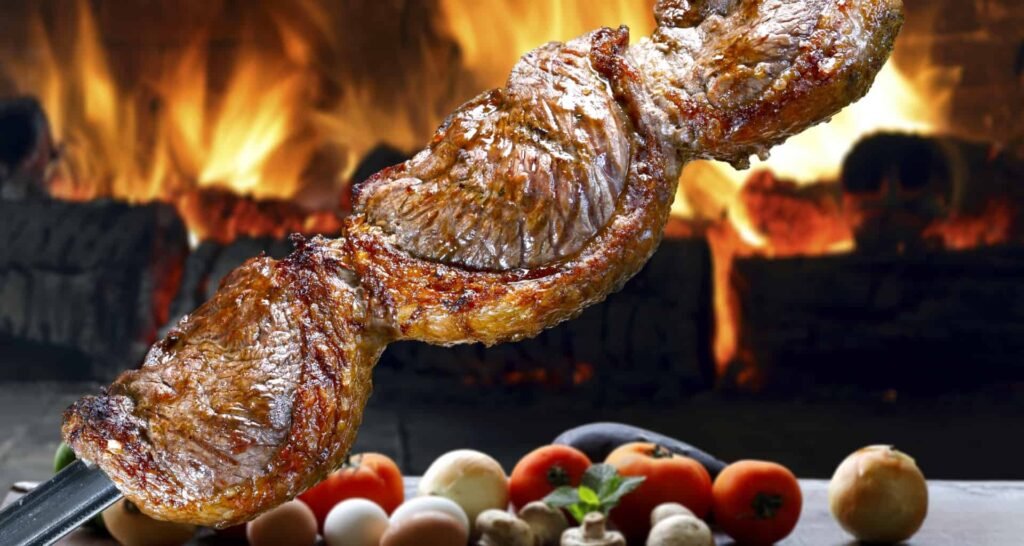
Brazilian Churrasco is a style of cooking that originated in the southern regions of Brazil and is now popular all over the country. This style of cooking is centered around the churrasqueira, a traditional grill that is used to cook a variety of meats to perfection. In this blog post, we will explore the history of Brazilian Churrasco and provide a recipe for you to try at home. History of Brazilian Churrasco Churrasco has its roots in the gaucho culture of southern Brazil, where cattle ranching was the primary industry. The gauchos, or cowboys, would gather around a fire and cook meat on skewers over an open flame, giving birth to the traditional Brazilian Churrasco. Over time, Churrasco evolved to include a wider variety of meats, including pork, chicken, and lamb, and became a popular way to celebrate special occasions such as weddings and family gatherings. Today, Churrasco is a staple in Brazilian cuisine and can be found in restaurants and homes all over the country. Recipe for Brazilian Churrasco Brazilian Churrasco Ingredients: Brazilian Churrasco Instructions: Brazilian Churrasco Cooking Time: The total cooking time for Brazilian Churrasco is approximately 30 minutes, with 15 minutes of active cooking time. Brazilian Churrasco Conclusion Brazilian Churrasco is a delicious and unique way of cooking that has become a staple in Brazilian cuisine. Its simple yet flavorful approach to grilling meats over an open flame is perfect for any occasion, from a casual backyard barbecue to a formal family gathering. With this recipe, you can now recreate the flavors of Brazilian Churrasco in the comfort of your own home and experience the tastes of Brazil for yourself. More Latin American Recipes More Brazilian Recipes Follow Us on Instagram
Discovering the Deliciousness of Brazilian Bobó de Camarão
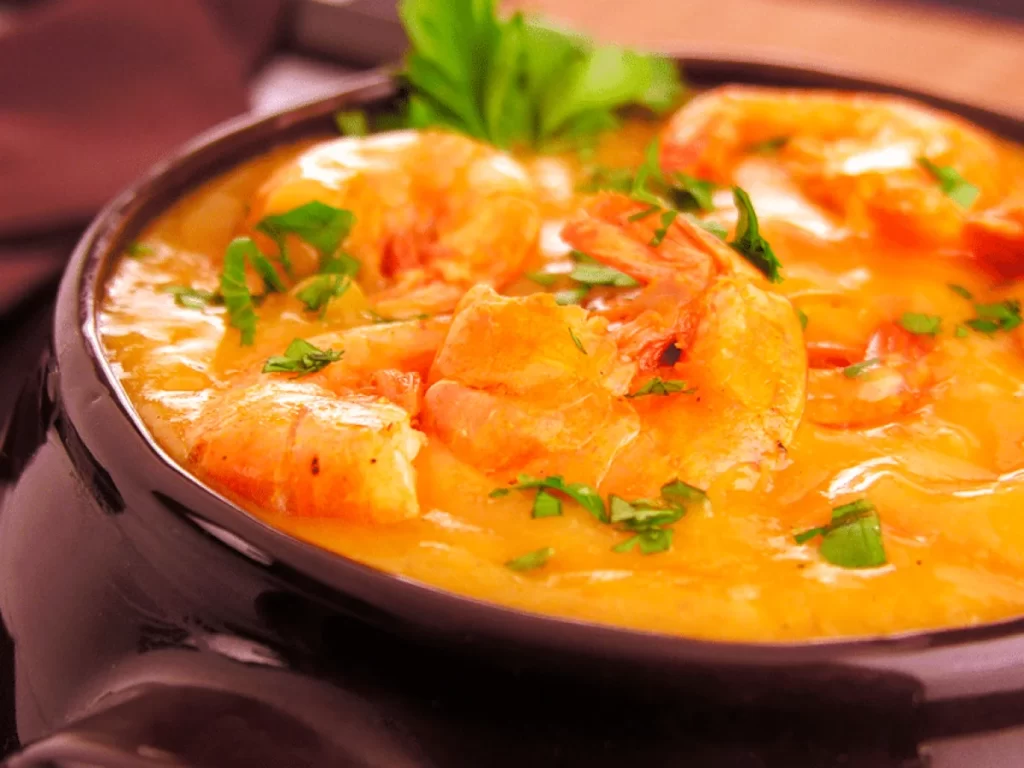
Brazilian cuisine is known for its vibrant flavors and unique combinations, and one dish that perfectly encapsulates this is the Bobó de Camarão. This creamy seafood stew is a favorite in Brazil and is made with fresh shrimp, cassava, coconut milk, and a variety of other ingredients. In this blog post, we will dive into the history and recipe of this delicious Brazilian dish. History of Bobó de Camarão Bobó de Camarão has its roots in the state of Bahia, located in northeastern Brazil. The dish has its origins in the Afro-Brazilian community and was influenced by African and indigenous cultures. Cassava, one of the main ingredients in the dish, was a staple crop in the indigenous communities of Brazil, while the addition of coconut milk was influenced by the African culture. Over time, the dish evolved and became popular throughout Brazil. Today, Bobó de Camarão can be found on menus in restaurants all over the country and is enjoyed by locals and tourists alike. Recipe for Bobó de Camarão Bobó de Camarão Ingredients: Bobó de Camarão Instructions: Bobó de Camarão Cooking Time: The total cooking time for Bobó de Camarão is approximately 1 hour and 15 minutes, with 35 minutes of active cooking time. Bobó de Camarão Conclusion Bobó de Camarão is a delicious and unique dish that perfectly showcases the flavors of Brazilian cuisine. Its creamy texture, fresh seafood, and blend of spices make it a must-try for anyone interested in exploring the diverse and vibrant flavors of Brazil. With this recipe, you can now make this classic dish in the comfort of your own home and experience the tastes of Brazil for yourself. More Latin American Recipes More Brazilian Recipes Follow Us on Instagram
Exploring the Delightful World of Brazilian Pão de Queijo
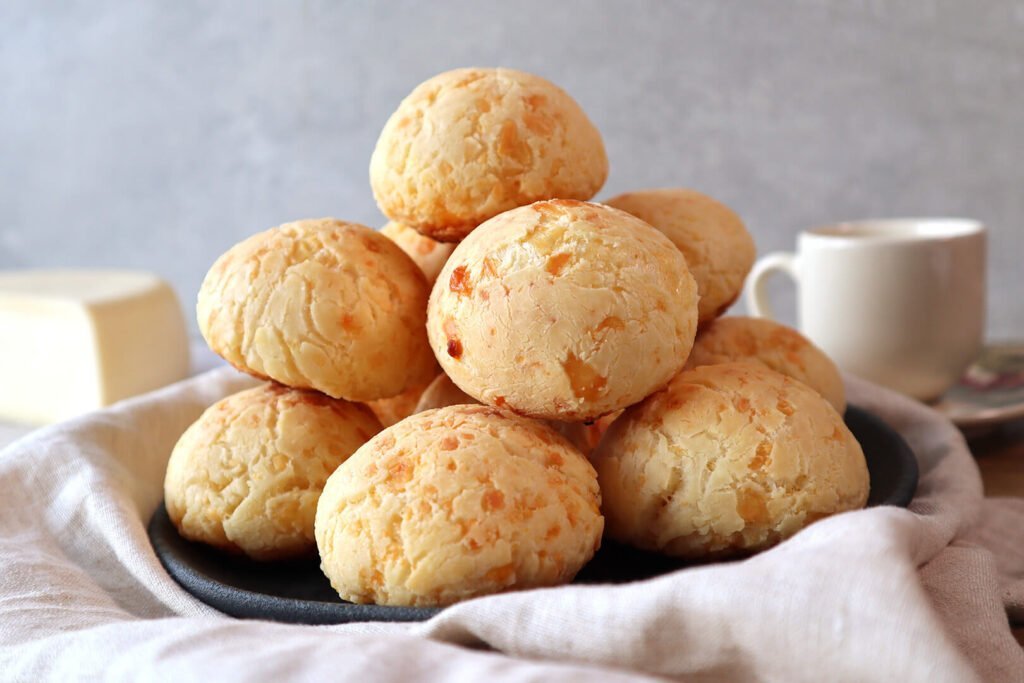
Brazilian cuisine is known for its rich and diverse flavors, and one of its most beloved dishes is pão de queijo. This delicious snack, which translates to “cheese bread” in English, is a popular street food in Brazil and has gained a following around the world. In this post, we’ll dive into the history of pão de queijo, explore its flavor profile, and provide you with a recipe to make it at home. History of Pão de Queijo Pão de queijo is believed to have originated in the Brazilian state of Minas Gerais in the 18th century. The dish was created by African slaves who used cassava starch, which was abundant in the region, to make a simple bread. The recipe evolved over time, and cheese was eventually added to the mix to create the delicious snack that we know and love today. Pão de queijo quickly became popular throughout Brazil and is now a staple in Brazilian cuisine. It’s commonly served as a snack or breakfast item, and can be found in bakeries, cafes, and street vendors throughout the country. In recent years, pão de queijo has gained a global following and is now enjoyed in many other countries around the world. Pão de Queijo Flavor Profile Pão de queijo is a unique and flavorful snack that combines the savory taste of cheese with the subtle sweetness of cassava starch. The bread has a crispy exterior and a soft and chewy interior, making it a delightful combination of textures. The cheese used in pão de queijo can vary, but traditionally, it’s made with queijo minas, a mild and creamy cheese that is also from the Minas Gerais region. Pão de queijo also has a slightly tangy flavor due to the addition of sourdough, which is used to give the bread its characteristic texture. The bread is typically served warm, which enhances the flavor and makes it even more enjoyable. Pão de Queijo Recipe and Cooking Time Now that you know a bit more about the history and flavor of pão de queijo, let’s dive into a recipe that you can make at home. Here’s what you’ll need: Pão de Queijo Ingredients: Pão de Queijo Instructions: The cooking time for pão de queijo is relatively quick, making it a great snack to whip up for a last-minute gathering or as an afternoon treat. The recipe we’ve provided makes about 30 pão de queijo balls, so it’s perfect for sharing with friends and family. In conclusion for Pão de Queijo Pão de queijo is a delicious and unique snack that has become a staple in Brazilian cuisine. Its history, flavor profile, and popularity have made it a beloved snack around the world. With this recipe, you can now enjoy the flavors of Brazil in the comfort of your own home. When it comes to serving pão de queijo, the possibilities are endless. You can enjoy them on their own as a snack or pair them with coffee for a delicious breakfast. Pão de queijo can also be served as an appetizer or side dish, and can be paired with a variety of dips or sauces. In Brazil, it’s common to see pão de queijo served with coffee or açaí bowls. The snack is also often served at parties and gatherings, where it’s enjoyed by both children and adults alike. In recent years, pão de queijo has become increasingly popular around the world. You can now find pão de queijo in specialty food stores and Brazilian restaurants in many countries. The snack has even gained a following on social media, with food bloggers and influencers sharing their own unique takes on the classic recipe. In conclusion, pão de queijo is a delicious and unique snack that has become a beloved staple in Brazilian cuisine. Its history, flavor profile, and popularity make it a must-try for anyone interested in exploring the flavors of Brazil. So why not try making a batch at home and enjoy the taste of Brazil in the comfort of your own kitchen? More Latin American Recipes More Brazilian Recipes Follow Us on Instagram
Brazilian Moqueca: A Hearty and Flavorful Seafood Stew
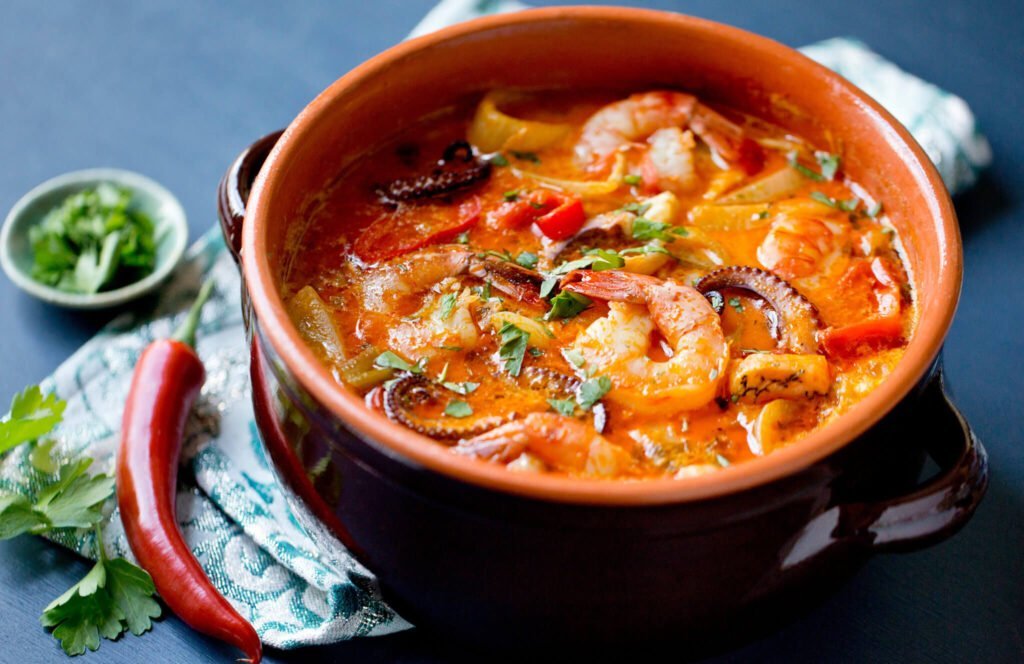
If you’re a fan of seafood, you’ve probably heard of Brazilian moqueca. This flavorful stew is a staple of Brazilian cuisine, and is made with fish, shrimp, or a combination of both, along with vegetables, coconut milk, and spices. In this blog post, we will explore the history of moqueca, the recipe, and how to make it in your own kitchen. History of Brazilian Moqueca Moqueca is a dish that originated in the northeastern state of Bahia in Brazil. It is believed to have been brought to Brazil by African slaves, and has since become a popular dish throughout the country. There are two main types of moqueca: moqueca baiana, which is made with dendê oil (palm oil), and moqueca capixaba, which is made with olive oil. Both types are delicious, but the use of dendê oil gives moqueca baiana a distinct and flavorful taste. Recipe for Brazilian Moqueca Moqueca Ingredients: Moqueca Instructions: Cooking Time for Brazilian Moqueca The cooking time for moqueca can vary depending on the type of seafood you use and the size of the chunks. In general, you’ll want to cook the fish for about 5-7 minutes, and the shrimp for about 3-4 minutes. The sauce should cook for about 10-15 minutes, until it has thickened and the seafood is fully cooked. It’s important to keep an eye on the seafood as it cooks, as overcooking can make it tough and rubbery. Moqueca Conclusion Brazilian moqueca is a hearty and flavorful seafood stew that is loved by Brazilians and seafood lovers around the world. With its combination of fish, shrimp, vegetables, and spices, it’s the perfect dish for any occasion. Whether you’re looking for a hearty meal for a chilly night or a delicious dinner party dish, moqueca is a great choice. So grab some fresh seafood, coconut milk, and spices, and try making this delicious Brazilian dish in your own kitchen. It’s a great way to explore new flavors and cuisines, and share it with friends and family. As with any recipe, there are variations of moqueca that you can try. Some people like to add dendê oil for a more traditional flavor, while others prefer to use olive oil for a milder taste. You can also experiment with different types of seafood, or add additional vegetables to the stew. In Brazil, moqueca is often served with rice and farofa, which is a toasted cassava flour that is commonly used as a side dish in Brazilian cuisine. This combination of flavors and textures is sure to delight your taste buds and satisfy your appetite. In conclusion, Brazilian moqueca is a dish that is steeped in tradition and history, and is beloved by people all over the world. With its rich blend of seafood, vegetables, and spices, it’s the perfect dish for any occasion, whether you’re hosting a dinner party or simply looking for a hearty and flavorful meal. So why not try making moqueca in your own kitchen today? You won’t regret it! More Latin American Recipes More Brazilian Recipes Follow Us on Instagram
Brazilian Coxinha: A Delicious and Savory Snack
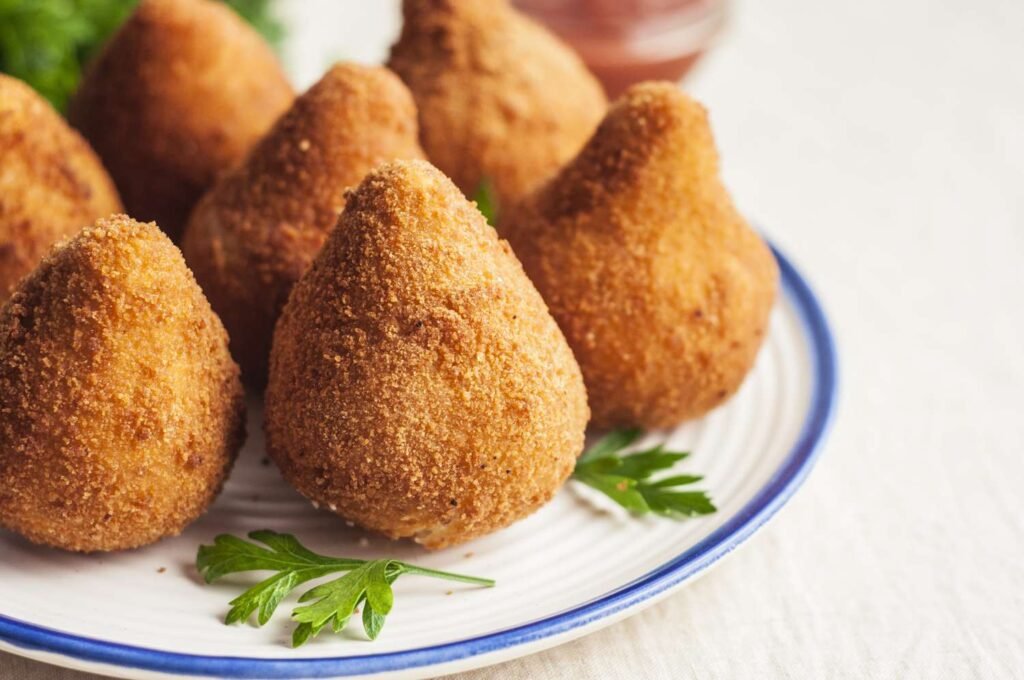
If you’re looking for a tasty and satisfying snack, look no further than Brazilian coxinha. These teardrop-shaped fritters are made with shredded chicken and spices, and are a favorite among Brazilians and food lovers around the world. In this blog post, we will explore the history of coxinha, the recipe, and how to make them in your own kitchen. History of Brazilian Coxinha Coxinha is a popular snack in Brazil, and is often eaten as a street food or at parties and celebrations. It is believed to have originated in the state of São Paulo, and has been a staple of Brazilian cuisine for over a century. The name coxinha means “little thigh” in Portuguese, and refers to the teardrop shape of the fritter, which is meant to resemble a chicken thigh. Coxinha is traditionally made with shredded chicken, spices, and a dough made with flour, milk, and butter. The dough is shaped into a teardrop shape, filled with the chicken mixture, and then breaded and deep-fried. Today, there are many variations of coxinha, including vegetarian and cheese-filled versions. Recipe for Brazilian Coxinha Brazilian Coxinha Ingredients: Brazilian Coxinha Instructions: Cooking Time for Brazilian Coxinha The cooking time for coxinha can vary depending on the size of the fritters and the heat of the oil. In general, they should be fried until they are golden brown and crispy, which takes about 3-5 minutes. It’s important to make sure the oil is hot enough before frying the coxinha, as this will help them cook evenly and prevent them from becoming greasy. Brazilian Coxinha Conclusion Brazilian coxinha is a delicious and savory snack that is loved by Brazilians and food lovers around the world. With its teardrop shape and flavorful filling, it’s the perfect snack for any occasion. Whether you’re looking for a tasty street food or a delicious party snack, coxinha is a great choice. So why not try making them in your own kitchen today? More Latin American Recipes More Brazilian Recipes Follow Us on Instagram
Brazilian Brigadeiros: A Delicious Treat for Any Occasion
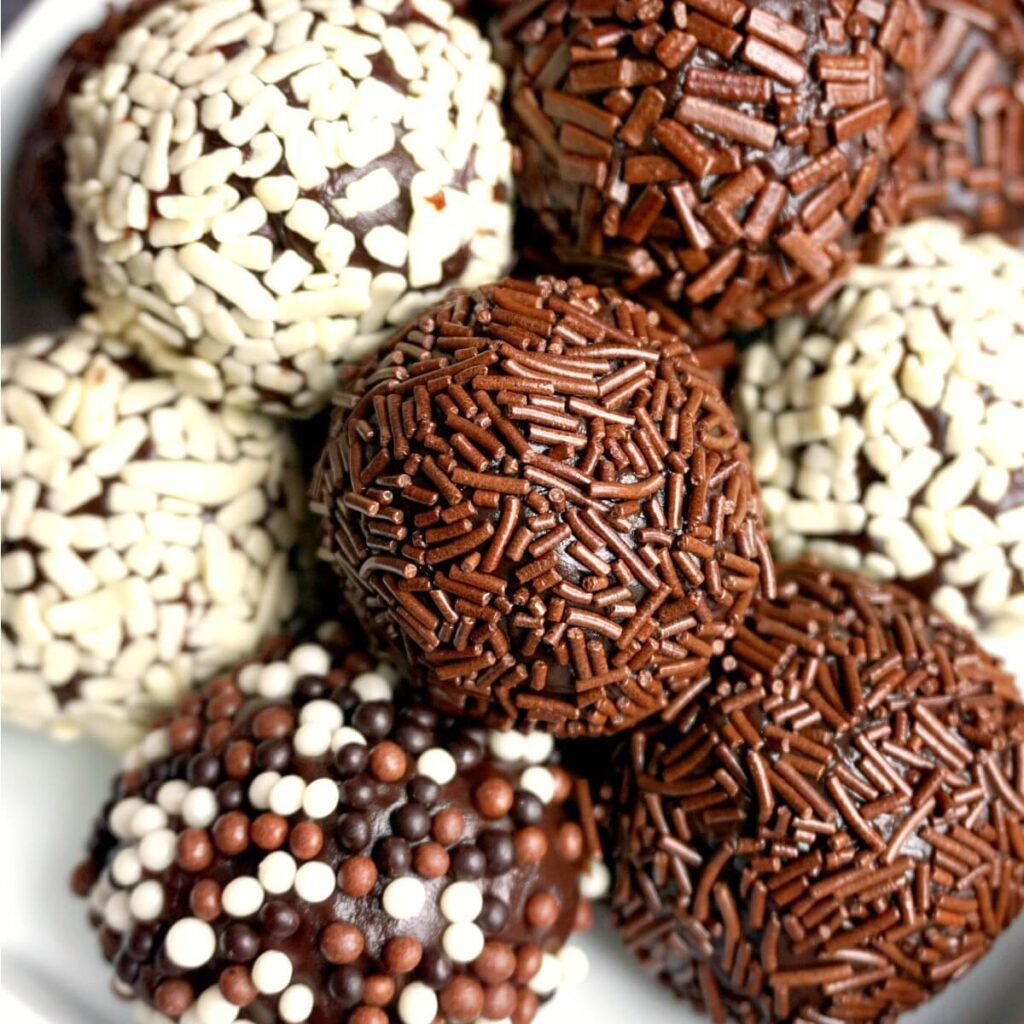
Brazilian brigadeiros are a classic and delicious sweet treat that is enjoyed by people of all ages in Brazil and around the world. These small chocolate balls are a staple at parties and celebrations, and are a favorite among children and adults alike. In this blog post, we will explore the history of brigadeiros, the recipe, and how to make them in your own kitchen. History of Brazilian Brigadeiros The brigadeiro was first created in the 1940s, during Brazil’s campaign for a new president. One of the candidates was Brigadeiro Eduardo Gomes, a well-known air force brigadier general. His supporters wanted to create a dessert in his honor, and thus the brigadeiro was born. It quickly became a popular treat in Brazil, and is now a staple at birthday parties, weddings, and other celebrations. Brigadeiros are easy to make and require only a few simple ingredients. Traditionally, they are made with condensed milk, cocoa powder, butter, and chocolate sprinkles. However, there are now many variations of brigadeiros, including white chocolate, pistachio, and coconut. Recipe for Brazilian Brigadeiros Brigadeiros Ingredients: Brigadeiros Instructions: Cooking Time for Brazilian Brigadeiros The cooking time for brigadeiros can vary depending on the heat of your stove and the thickness of the mixture. However, in general, it should take around 10-15 minutes to cook the mixture over medium heat. It’s important to stir the mixture constantly to prevent it from burning or sticking to the pan. Once the mixture thickens and starts to pull away from the sides of the pan, it’s ready to be removed from the heat. Brigadeiros Conclusion Brazilian brigadeiros are a delicious and easy-to-make sweet treat that is enjoyed by people of all ages. With just a few simple ingredients and a little bit of time, you can create these small chocolate balls that are perfect for any occasion. Whether you’re celebrating a birthday, a wedding, or just want a sweet treat to enjoy with your family and friends, brigadeiros are a great choice. So why not try making them in your own kitchen today? More Latin American Recipes More Brazilian Recipes Follow Us on Instagram
Tarta de Jamón: The Classic Ham and Cheese Tart of Argentina

One of Argentina’s most beloved dishes is tarta de jamón y queso, or ham and cheese tart. This savory pastry is a staple of Argentine cuisine and is enjoyed by both locals and visitors alike. In this post, we will explore the history of tarta de jamón y queso, as well as provide a recipe and cooking instructions so you can make it at home. The History of Tarta de Jamón y Queso Tarta de jamón y queso has its roots in the French quiche, which was introduced to Argentina by French immigrants in the 19th century. Over time, the dish evolved to incorporate local ingredients and flavors, such as ham and cheese. Today, tarta de jamón y queso is a staple of Argentine cuisine and is served in homes, restaurants, and cafes throughout the country. It is often enjoyed as a quick and easy meal or snack, and is especially popular for breakfast or lunch. Recipe for Tarta de Jamón y Queso Tarta de Jamón y Queso Ingredients: Tarta de Jamón y Queso Instructions: Tarta de Jamón y Queso Cooking Time Tarta de jamón y queso takes about 10-15 minutes to prepare and 35-40 minutes to bake. The key to a successful tart is to make sure that the filling is fully cooked and set before removing it from the oven. To test if the filling is done, insert a toothpick into the center of the tart. If it comes out clean, the tart is ready. Variations on Tarta de Jamón y Queso While tarta de jamón y queso is traditionally made with ham and cheese, there are many variations on this classic dish. Some chefs add onions or peppers to the filling, while others use different types of cheese or meat. Another popular variation is to make mini tarts instead of a large one. These are perfect for parties or as a snack, and can be made using a muffin tin or mini pie dishes. Tarta de Jamón y Queso Conclusion Tarta de jamón y queso is a delicious and versatile dish that is perfect for any meal of the day. By following the recipe and cooking instructions provided in this post, you can easily create your own version of this classic Argentine dish. And by experimenting with different fillings and seasonings, you can put your own spin on it and make it your own. So why not give it a try and experience the flavors of Argentina for yourself? More Latin American Recipes More Argentinian Recipes Follow Us on Instagram
Provoleta: The Sizzling Grilled Cheese of Argentina
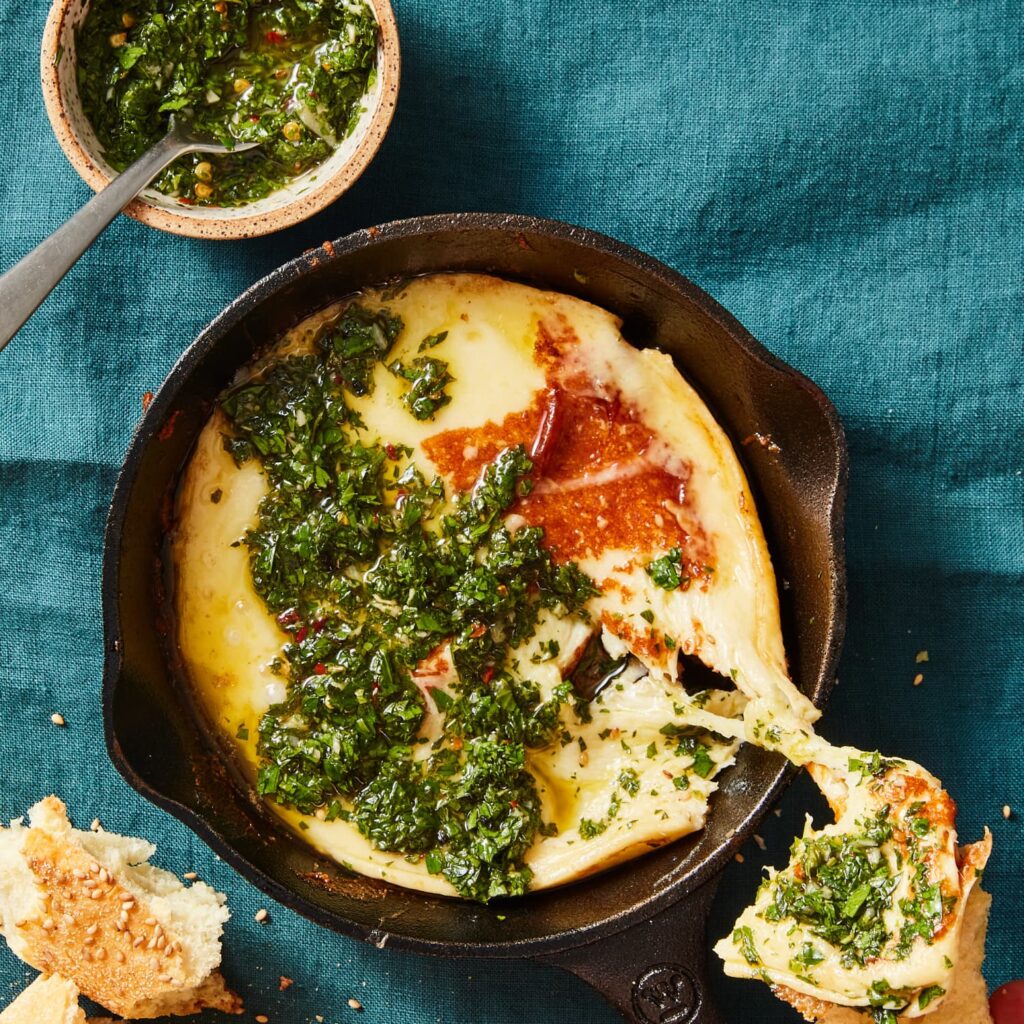
Argentina is a country known for its delicious and unique cuisine, and one dish that stands out is provoleta. This popular dish is made with a type of cheese called provolone, which is a semi-hard cheese with a mild, smoky flavor. Provoleta is typically grilled or pan-fried, and is often served as an appetizer or side dish. In this post, we will explore the history of provoleta, as well as provide a recipe and cooking instructions for this delicious dish. The History of Provoleta Provolone cheese was brought to Argentina by Italian immigrants in the late 19th and early 20th centuries. The cheese quickly became popular in Argentina, and was used in a variety of dishes. Provoleta, however, is a more recent creation. It is believed to have originated in the city of Buenos Aires in the 1960s, and quickly spread throughout the country. Today, it is a staple of Argentine cuisine, and is enjoyed by locals and tourists alike. Recipe for Provoleta Provoleta Ingredients: Provoleta Instructions: Provoleta Cooking Time Provoleta is a quick and easy dish to prepare, and can be ready in just a few minutes. The key is to make sure that the skillet or grill is hot before adding the cheese slices, and to cook them for just a few minutes on each side until they are golden brown and slightly melted. Variations on Provoleta While provoleta is traditionally made with provolone cheese and seasoned with oregano and red pepper flakes, there are many variations on this classic dish. Some chefs add garlic or onion to the seasoning mixture, while others top the cheese with sliced tomatoes or roasted peppers. Another popular variation is to add a few slices of ham or bacon to the provoleta, creating a delicious and indulgent dish that is perfect for a special occasion. Conclusion of Provoleta Provoleta is a delicious and unique dish that is beloved by many in Argentina and around the world. Whether served as an appetizer or side dish, it is sure to impress with its smoky flavor and gooey texture. By following the recipe and cooking instructions provided in this post, you can easily create your own version of provoleta at home. And by experimenting with different seasonings and toppings, you can put your own spin on this classic dish and make it your own. So why not give it a try and experience the flavors of Argentina for yourself? More Latin American Recipes More Argentinian Recipes Follow Us on Instagram
Locro: A Hearty and Delicious Stew from Argentina
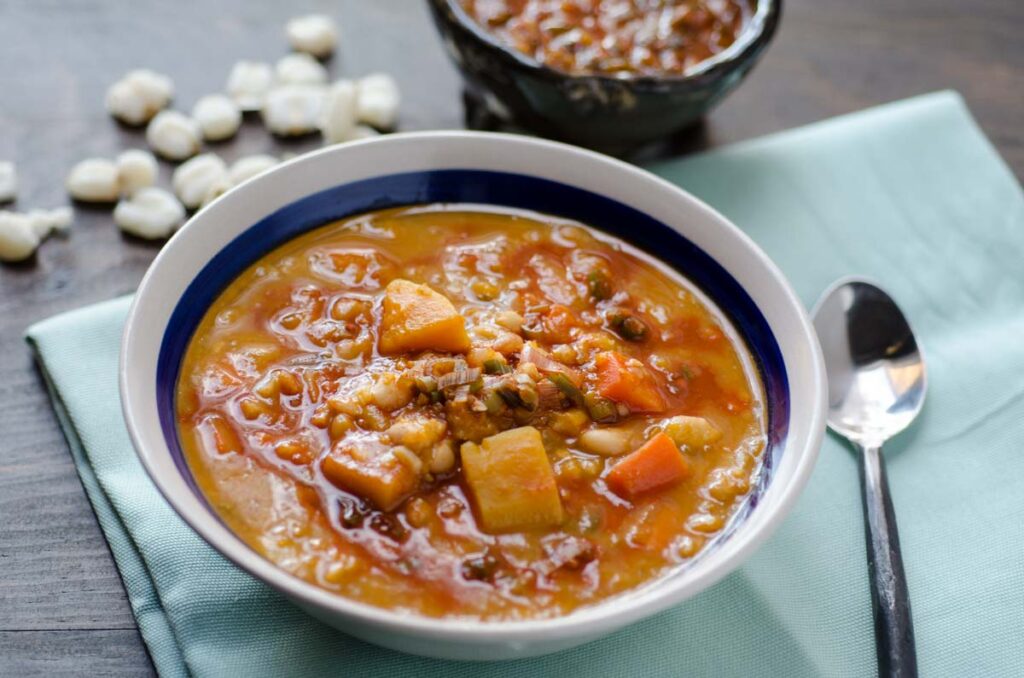
Locro is a traditional Argentinean stew made with corn, beans, and meat. This hearty dish is often enjoyed during the winter months, as it is warm, filling, and packed with flavor. In this blog post, we will explore the history of locro, as well as provide a recipe for you to try at home. History of Locro Locro has been a staple of Argentinean cuisine for centuries. It originated with the indigenous people of the Andean region, who used corn, beans, and other local ingredients to create a hearty and nutritious stew. Over time, the dish evolved and was adapted by Spanish colonizers and African slaves, who added their own flavors and techniques to the mix. Today, locro is a beloved part of Argentinean culture. It is often served on patriotic holidays, such as Independence Day and May Day, as a symbol of national unity and identity. It is also a popular dish for family gatherings and social events, as it can easily feed a large crowd. Locro Recipe Locro Ingredients: Locro Instructions: Locro Cooking Time The cooking time for locro can vary depending on the method you choose. The recipe above takes approximately 2-3 hours, but if you use a slow cooker or pressure cooker, the cooking time may be shorter. The key is to cook the stew until the corn is tender and the flavors have melded together. Tips for Making Locro Locro Conclusion Locro is a delicious and hearty stew that is a beloved part of Argentinean cuisine. Whether you’re celebrating a special occasion or simply looking for a warm and satisfying meal, loc ro is a dish that is sure to please. With its blend of corn, beans, and meat, it is a filling and nutritious meal that is perfect for the winter months. And with its rich history and cultural significance, it is a dish that represents the unique flavors and traditions of Argentina. So why not try making locro at home? With the recipe provided above, you can create a delicious and authentic version of this classic dish. And by experimenting with different meats and toppings, you can put your own spin on this timeless recipe. Whether you’re a seasoned cook or a beginner, locro is a dish that is easy to make and sure to impress. So gather your ingredients, fire up the stove, and get ready to enjoy a taste of Argentina with this delicious and hearty stew. More Latin American Recipes More Argentinian Recipes Follow Us on Instagram
